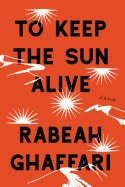
Filmmaker Rabeah Ghaffari's debut novel, To Keep the Sun Alive, is a story of grand scale told with humility, precision and vivid sensory detail. It centers on a family that maintains a fruit orchard amid the ruins of the provincial Iranian town of Naishapur--the once-great intellectual center of the Islamic world that has since been leveled by centuries of war and conquest. Like the landscape they inhabit, Ghaffari's characters are representative of a time quickly fading from memory: they cook elaborate meals, dine slowly with their friends, take siestas in the afternoon sun, bring bread to their neighbors and remain just as attuned to pagan tradition as they are to Islamic tradition. But as the Iranian Revolution occurs, this family experiences profound changes to their way of life, and are taken down divergent paths.
Although To Keep the Sun Alive is a domestic novel deeply concerned with the intimacy and comforts of home, Ghaffari doesn't stray from exploring the political implications of domesticity. She presents her readers with a kaleidoscopic view of Iranian culture that situates the Islamic Revolution as a particular moment in history that, in many ways, is at odds with Islamic intellectual tradition. Ghaffari's characters share parables and carry out impassioned debates that help readers understand the tensions between the competing ideologies of the cultural moment, and what precisely is at stake for the Iranian people in the revolution. This is a rich, evocative and thoroughly impressive first novel. --Emma Levy, bookseller at Third Place Books Seward Park, Seattle, Wash.

